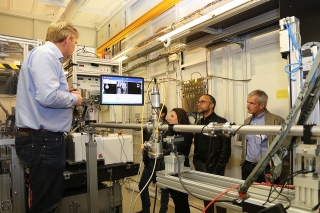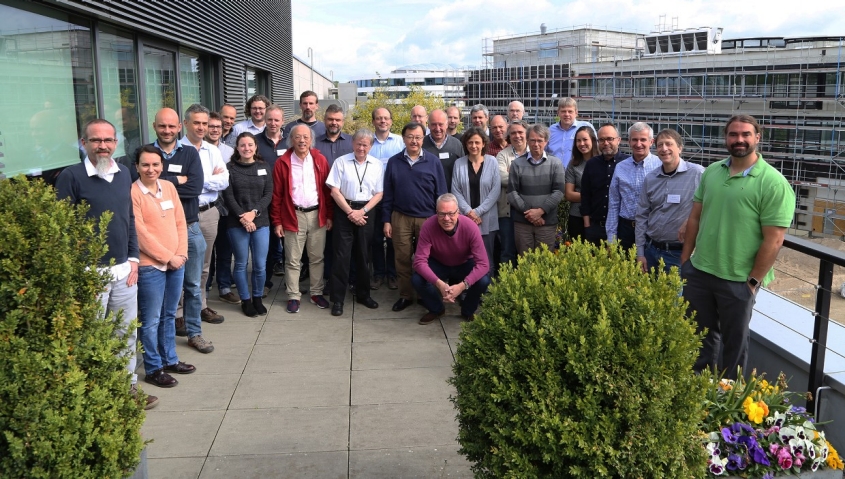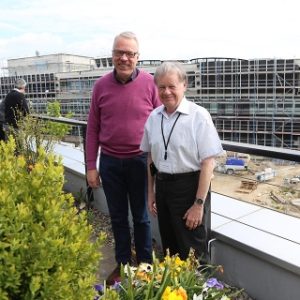Forming bonds to advance research – successes from the first EMBL-Stanford Structural Biology Workshop


Photo credit: Christiana Franke
What is the best way to push developments in a field of biology? According to Keith Hodgson, professor of photon science at Stanford, bringing together some of the top researchers “to talk and think about their common areas of opportunities and challenges – that’s what it’s all about”.

Last month, Keith and Matthias Wilmanns, Head of EMBL Hamburg, organised the first joint EMBL-Stanford Structural Biology Workshop as part of the Life Science Alliance. Researchers from Stanford joined colleagues from EMBL’s sites in Heidelberg, Grenoble and Hamburg to discuss cutting-edge research and technology, and how they can work together to advance their field. For Matthias, the value of working with Stanford is obvious: “I feel very privileged working at EMBL with its internationality. We have 26 member states, we do workshops all over the world but I think having a strong connection to leading organisations North America generates outstanding opportunities as well.
Held at the EMBL Hamburg Unit on the DESY campus, one of the world’s leading accelerator centres, researchers were in the perfect environment to share research and ideas, as well as to experience some of the cutting-edge facilities first-hand – including a visit to European XFEL.
The workshop focused on technology and methods in structural biology, with presentations on hot topics ranging from structural characterisation of complexes involved in axon guidance to a systematic investigation of nitrogen-cycling enzymes in ammonia-oxidising archaea. Sessions also covered cutting-edge cryo-electron microscopy research, as well as novel X-ray techniques including plans for a high-energy X-ray free-electron laser, LCLS II, at SLAC, and the automated CystalDirect harvester co-developed by EMBL researchers and Arinax (a spin-off in Grenoble).
Going beyond presenting the latest research, Keith and Matthias wanted to, in Keith’s words, “build on mutual scientific and technical interests for synergy and exchange of ideas between the two facilities”. At the end of each session, discussion panels catalysed the exchange of ideas on the future opportunities and challenges in the field.
During these vibrant discussions, automation, machine learning and the development of hybrid methods (for example time-resolved 4D structural biology) were seen as great possibilities for development.
However, it was also noted that advances in automation and a resulting increase in remote-access users mean that in-depth training is less common, so specialist knowledge in structural biology is likely to become increasingly rare. Thomas Schneider, group leader at EMBL Hamburg, highlighted the importance of maintaining specialist knowledge by repeating the words of former EMBL Director General Iain Mattaj: “There is no multidisciplinarity without disciplines.” More broadly, communicating the importance and excitement of structural biology was also seen as a crucial objective for the wider community. Increasing the profile of structural biology is essential for attracting young scientists to the field, and also for making the general public and funding organisations more aware of its impact.
Having identified these possibilities and concerns, the researchers turned to how EMBL and Stanford could work together to address them. Matthias was enthusiastic about the response: “From what I heard there was a clear statement from EMBL and Stanford that there is a win-win situation by doing things together.” The scientists agreed that organising joint, in-depth training courses would help develop and maintain expertise. There was also a clear role for major facilities like those at SLAC and EMBL’s Hamburg and Grenoble and Heidelberg sites, not only for making technologies like small angle x-ray scattering, macromolecular crystallography, cryo electron microscopy and x-ray absorption spectroscopy and imaging accessible to the scientific community, but also to act as centralized hubs for specialist knowledge. Organising outreach events to inform the public and get students excited about a career in structural biology would also help in the long-term development of the field.
“You have an idea what people at EMBL are doing. But you need to follow this in a more concentrated function that allows you to go deeper to identify the common ground and the differences that we can take advantage of and help each other with.”
After the success of the first workshop, Keith and Matthias have no doubts about holding a second at Stanford. However, strengthening the bonds that were formed and developing deeper collaborations would require something bigger. For Keith, the Life Science Alliance offers researchers the perfect opportunity to do so by “generating something more sustainable, with something that’s larger like a postdoc programme or exchange programme that provides the ability to work across these boundaries”. Fellow Life Science Alliance member Georgios Skiniotis, who works with EMBL group leader Rob Meijers on understanding dosage dependence mechanisms in Down syndrome, believes these types of activities are essential for moving from ideas and discussions to effective collaborations. “You have an idea what people are up to and what people at EMBL are doing,” says Georgios. “But you need to follow this in a more concentrated function that allows you to go deeper to identify the common ground and the differences that we can take advantage of and help each other with.”
Keith and Matthias, together with the Life Science Alliance, would like to thank the Joachim Herz Stiftung for generously providing financial support for this workshop.